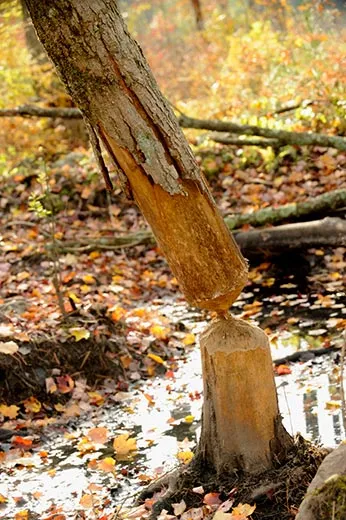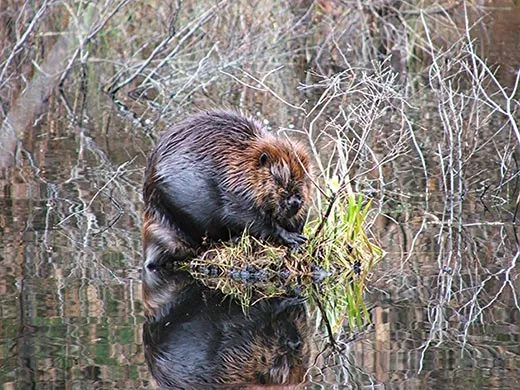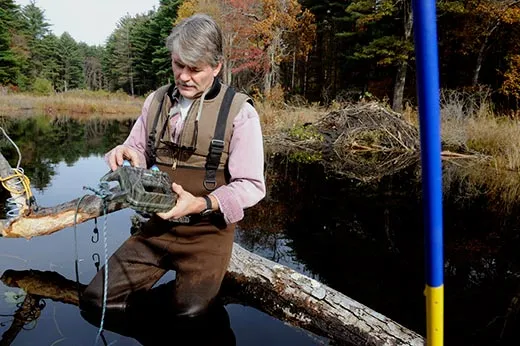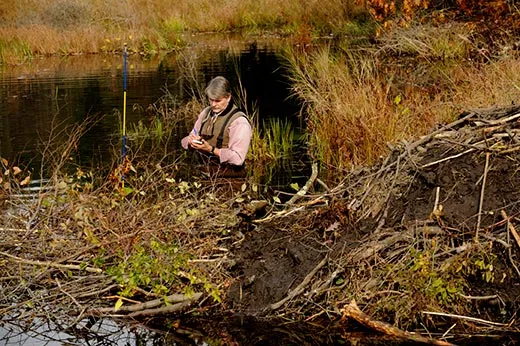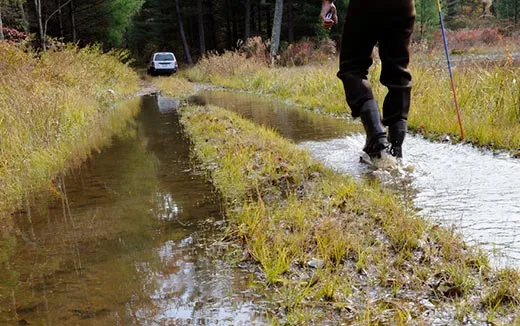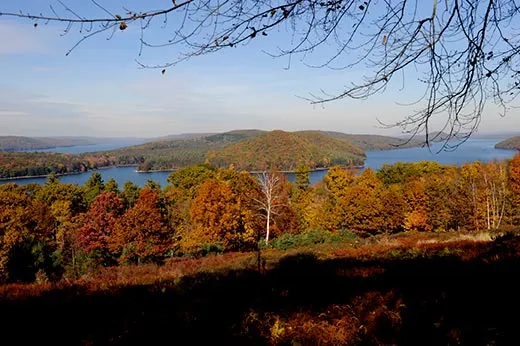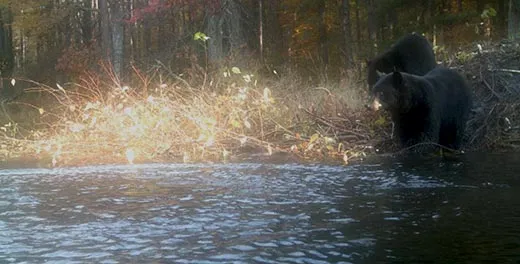Beavers: The Engineers of the Forest
Back from the brink of extinction, the beavers of Massachusetts are a crucial component of a healthy ecosystem
/https://tf-cmsv2-smithsonianmag-media.s3.amazonaws.com/filer/beaver-at-Prescott-Peninsula-631.jpg)
Our car rolls slowly down a dirt road in central Massachusetts. A leafy canopy of oak and red maple arches overhead, dripping from recent rains. Two broad ponds flank the road, and a beaver lodge rises in each one. The shaggy domes, each about ten feet across, are built from cut branches and sealed with mud. Between the ponds, the road lies under several inches of water.
“They’ve plugged the culvert. The watershed managers won’t like that,” says Boston University biologist Peter Busher. His grin signals which side he’s on. We park and slosh forward on foot to investigate. Standing ankle-deep at the crime scene and peering down, we can see that beavers, probably spurred to action by the sound of running water, have jammed the drain under the road with sticks and wads of grass.
Busher thinks that both lodges belong to one family group that moves back and forth between the ponds. Plugging the culvert allows them to swim across the road instead of climbing out and walking across. Their dam won’t last long—state foresters will clear the culvert—but every bit of trouble the beavers cause here is data for Busher.
The ponds are on Prescott Peninsula, which juts into the Quabbin Reservoir, a 25,000-acre lake that provides drinking water for metropolitan Boston. The narrow, ten-mile-long peninsula is a restricted area, accessed mainly for water testing and selective tree-cutting. The longest-running beaver population study began here in 1969, and Busher has been tracking the Prescott Peninsula beavers’ numbers and behavior since 1982. He and other scientists studying beavers around the country have discovered that the animals provide valuable habitat for many other species, and do it very cheaply.
Beavers have long been recognized as the engineers of the forest, constantly reshaping their surroundings. “One has but to observe a community of beavers at work in a stream to understand the loss in his sagacity, balance, co-operation, competence, and purpose which Man has suffered since he rose up on his hind legs,” wrote humorist James Thurber in 1939. The Massachusetts Institute of Technology chose beavers a century ago as mascots because, like MIT students, they were skilled engineers and nocturnal workaholics.
Like other rodents, beavers have large front teeth that never stop growing, so the animals never stop gnawing. They eat bark, leaves, roots and twigs from a variety of trees, with a preference for aspen and sugar maples as well as waterlily roots. They feed primarily on the cambium, a layer of soft living tissue under the bark that carries moisture and nutrients to the tree’s leaves and branches.
Beavers mate for life and live in colonies that usually number five or six—a breeding pair, several kits, and one or two yearlings that will move out at age 2. They are territorial, so one family group won’t typically share a pond with another colony. When beavers move to a new area, they tunnel into pond or stream banks, break through to the surface and start piling sticks on top of the hole to build a lodge. Next they cut down branches and use them to dam the stream so that water rises around the lodge, creating a protective moat.
Before European settlement, an estimated 60 million beavers ranged across North America. As recently as 1600, beaver ponds covered more than 10 percent of the territory around the upper Mississippi and Missouri rivers. Their ponds stored water and sustained stream flows. But English, French and Dutch explorers prized beavers for another reason: their dense, water-resistant fur. Lewis and Clark kept careful records of wildlife sightings as they explored Louisiana Purchase lands from 1803 through 1806; their reports of abundant beavers along the upper Missouri and Yellowstone rivers spurred 30 years of intensive trapping across the Great Plains. Beavers had been hunted and trapped close to extinction across most of the continent by 1840.
In the early 1900s, however, conservationists and sportsmen began to lobby for reintroduction programs and trapping limits. Massachusetts reintroduced beavers starting in 1932, when no beavers were known to live in the state. It now has an estimated 70,000.
Today there’s growing awareness that beavers don’t just rearrange ecosystems–they make them healthier. Their dams create wetlands that take up floodwaters, preventing flash floods. Studies in Colorado and Canada have shown that beaver ponds make droughts less devastating by raising groundwater levels and keeping soils moist in the absence of rain. Land managers in several Western states are studying beaver restoration as a way to slow spring runoff from melting snow (recent droughts and warmer spring temperatures have made it more difficult to store water into the summer in many parts of the West). Beaver ponds also filter out sediments and pollutants, says Laura Hajduk, a biologist with the Massachusetts Division of Fisheries and Wildlife. "They’re great purifiers. Often the water that comes out is cleaner than what went in.”
And beaver ponds provide habitat for many types of animals. That’s evident as Busher and I hop across the flooded culvert. A great blue heron flaps up from nearby marsh grass, and we hear the deep, hollow thrum of a pileated woodpecker boring into a tree. When we climb from the bank onto a cement-hard beaver lodge, newts scramble for cover in the shallows. Broken eggshells are scattered underfoot–the remains of a snapping turtle nest on top of the lodge, raided by an unknown predator. Browsing moose have left massive tracks in the mud. “It’s much more diverse here than it would be if the land was drained,” says Busher. “But you do lose some trees.” Standing dead trees, killed by rising waters, are a feature of beaver ponds, along with gnawed-off stumps. But those dead trees provide homes for wood ducks and other cavity-nesting birds. And plenty of healthy hardwoods remain around the ponds, including some large maples growing right at the water’s edge.
It’s not always this tranquil when beavers move into human neighborhoods–an increasingly common occurrence across much of the United States. Here in the Northeast, forests have regrown over the past century as farming has declined, providing more beaver habitat, and hunting and trapping are limited in many areas. In Massachusetts, which banned most types of traps in 1996, beaver dams regularly flood roads, backyards and septic systems.
Under state law, beavers can be trapped when their activities threaten human health or safety. “Flooding sewer systems or wells, or damaging the structural stability of buildings, are the kind of impacts that justify trapping,” says Hajduk. But her agency advises that when beavers are simply an inconvenience, “tolerance is the best solution.” Fencing off ornamental trees and shrubs and installing specially designed pipes in dams to regulate water flow can reduce property damage.
Busher thinks many of the problems beavers are now causing for homeowners may be temporary. When beavers reappeared on the Prescott Peninsula in 1952, the number of colonies grew very slowly at first. Then the population spiked from 16 groups in 1968 to 46 in 1975 and remained high for nearly a decade. By 1992, however, it had plunged to 10 colonies, and since then it’s never risen higher than 23 colonies. “At the high point they were using every marginal spot, but that wasn’t sustainable,” says Busher. Once beavers ate all of the available plants in marginal areas, some left the peninsula, failed to breed, or died. Now the population is more stable. He’s documented a similar pattern of rapid growth followed by decline in California's Sierra Nevada. If that model holds true in the suburbs that beavers are now infiltrating, flooding problems may ease over the long term as beaver populations stabilize.
When beavers abandon a site, their ponds and marshes start to fill up with silt and eventually become “beaver meadows,” which provide habitat for many species of grassland birds. Farther down the peninsula we see abandoned dams covered with vegetation and ponds where water levels have dropped. Some of the lodges have holes in them, and they have no food caches—piles of freshly cut branches, some with leaves still on—that typically stretch out in front of an active lodge.
At the last pond, runoff from heavy rains cascades over a beaver dam that’s at least five feet high and 50 feet long. The beavers that built this dam moved upstream after watershed managers broke down a smaller dam that threatened to flood an access road – one of the few times Busher has seen beavers give up on a location so quickly. “It’s not always obvious why they choose one spot over another, or move on from what looks to us like a perfectly nice pond. They’ve got their own aesthetics,” he says.
